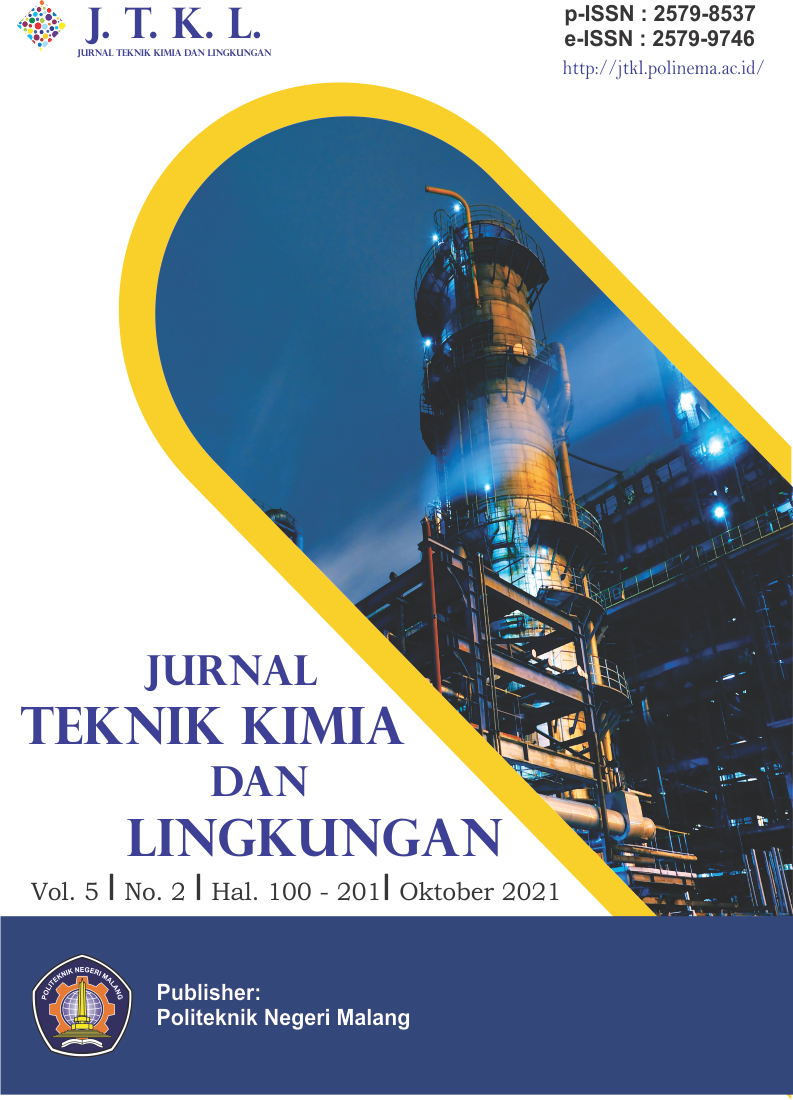Panas Pretreatment Tandan Kosong Kelapa Sawit dengan Sodium Hidroksida dan Asam Fosfat
DOI:
https://doi.org/10.33795/jtkl.v5i2.216Keywords:
Acid, base, heat, pretreatment, OPEFBsAbstract
Indonesia sebagai negara penghasil minyak kelapa sawit terbesar di dunia memiliki limbah tandan kosong kelapa sawit (TKKS) yang melimpah. TKKS ini dapat dikonversi menjadi berbagai bioproduk yang didahului dengan proses pretreatment. Pada penelitian ini akan diteliti perhitungan panas pretreatment TKKS dengan sodium hidroksida dan asam fosfat pada kondisi suhu rendah. Hasil penelitian menunjukkan bahwa panas pretreatment dengan menggunakan sodium hidroksida lebih tinggi dibandingkan dengan panas pretreatment dengan asam fosfat. Selain itu, berdasarkan variasi konsentrasi asam fosfat yang digunakan, semakin tinggi konsentrasi asam fosfat membuat panas pretreatment dengan menggunakan larutan asam fosfat semakin rendah. Perbedaan nilai panas pada pretreatment dengan menggunakan sodium hidroksida dan asam fosfat dipengaruhi oleh panas pembentukan dari masing-masing senyawa yang digunakan proses pretreatment. Panas pretreatment TKKS dengan 5% larutan sodium hidroksida menghasilkan panas sebesar 125 kJ. Sedangkan, panas pretreatment dengan menggunakan asam fosfat pada berbagai konsentrasi 70%, 75%, 80% dan 85% adalah 117 kJ, 103 kJ, 88 kJ dan 74 kJ.
Indonesia as the largest palm oil producing country in the world has abundant oil palm empty fruit bunches (OPEFBs). OPEFBs can be converted into various bioproducts which are preceded by pretreatment process. This research investigated the heat calculation of OPEFBs pretreatment with sodium hydroxide and phosphoric acid at low temperature conditions. The results showed that the heat using sodium hydroxide was higher than the heat using phosphoric acid. In addition, based on variation in phosphoric acid concentrations used, it was found that the higher concentration of phosphoric acid made the heat of phosphoric acid pretreatment became lower. The difference of heat value in sodium hydroxide and phosphoric acid pretreatment was influenced by the heat of formation in each compound used in the pretreatment process. Heat pretreatment of OPEFBs with 5% sodium hydroxide solution was 125 kJ. While, heat pretreatment using phosphoric acid at various concentrations of 70%, 75%, 80% and 85% were 117 kJ, 103 kJ, 88 kJ and 74 kJ.
References
USDA, (2020). Indonesia: Oilseeds and Product Update. URL https://www.fas.usda.gov/data/indonesia-oilseeds-and-products-update 15.
USDA, (2020). Malaysia: Oilseeds and Products Update. URL https://www.fas.usda.gov/data/malaysia-oilseeds-and-products-update-7.
USDA, (2020). Oilseeds: World Markets and Trades. URL https://www.fas.usda.gov/data/oilseeds-world-markets-and-trade.
R. Omar, A. Idris, R. Yunus, K. Khalid, M. I. Aida Isma, Characterization of Empty Fruit Bunch for Microwave-Assisted Pyrolysis, Fuel, vol. 90, no. 4, hal. 1536–1544, 2011.
P. L. Tang, W. L. Hong, C. S. Yue, S. Harun, Palm Oil Mill Effluent as the Pretreatment Solvent of Oil Palm Empty Fruit Bunch Fiber for Fermentable Sugar Production, Bioresource Technology, vol. 314, hal. 123723, 2020.
R. Masran, E. K. Bahrin, M. F. Ibrahim, L. Y. Phang, S. Abd-Aziz, Simultaneous Pretreatment and Saccharification of Oil Palm Empty Fruit Bunch using Laccase-Cellulase Cocktail, Biocatalysis and Agricultural Biotechnology, vol. 29, hal. 101824, 2020.
A. F. P. Harahap, J. R. H. Panjaitan, C. A. Curie, M. Y. A. Ramadhan, P. Srinophakun, M. Gozan, TechnoEconomic Evaluation of Hand Sanitizer Production Using Oil Palm Empty Fruit Bunch-Based Bioethanol by Simultaneous Saccharification and Fermentation (SSF) Process, Applied Science, vol. 10, no. 17, hal. 5987, 2020.
Z. Rathamat, W. Choorit, Y. Chisti, P. Prasertsan, Two – Step Isolation of Hemicellulose from Oil Palm Empty Fruit Bunch Fibers and Its Use in Production of Xylooligosaccharide Prebiotic, Industrial Crops and Products, vol. 160, hal. 113124, 2020.
N. Sritrakul, S. Nitisinprasert, S. Keawsompong, Evaluation of Dilute Acid Pretreatment for Bioethanol Fermentation from Sugarcane Bagasse Pith, Agriculture and Natural Resources, vol. 51, no. 6, hal. 512-519, 2018.
S. Pant, Ritika, A. Komesu, E. D. Penteado, A. A. R. Diniz, M. A. Rahman, A. Kuila, NaOH Pretreatment and Enzymatic Hydrolysis of Brassica Juncea using Mixture of Cellulases, Environmental Technology & Innovation, vol. 21, hal. 101324, 2020.
P. Lenihan, A. Orozco, E. O’Neill, M. N. M. Ahmad, W. Rooney, G. M. Walker, Dilute Acid Hydrolysis of Lignocellulosic Biomass, Chem. Eng. J., vol. 156, no. 2, hal. 395-403, 2010.
H. U. Syed, Cold Caustic Extraction of Spruce Sulfite Dissolving Pulp, M.Sc. thesis, Department of Chemical Engineering, Karlstad University, Karlstad, Swedia, 2012.
A. K. Obeng, D. Premjet, S. Premjet, Fermentable Sugar Production from the Peels of Two Durian (Durio zibethinus Murr.) Cultivars by Phosphoric Acid Pretreatment, Resources, vol. 7, no. 4, hal. 60, 2018.
M. Gozan, J. R. H. Panjaitan, D. Tristantini, R. Alamsyah, Y. J. Yoo, Evaluation of Separate and Simultaneous Kinetic Parameters for Levulinic Acid and Furfural Production from Pretreated Palm Oil Empty Fruit Bunches, International Journal of Chemical Engineering, vol. 2018, hal. 1920180, 2018.
J. R. H. Panjaitan, M. Gozan, Formic Acid Production from Palm Oil Empty Fruit Bunches, International Journal of Applied Engineering Research, vol 12, no. 14, hal. 4382-4390, 2017.
J. R. H. Panjaitan, S. Monica, M. Gozan, Production of Furfural from Palm Oil Empty Fruit Bunches: Kinetic Model Comparison, in: International Conference on Biomass: Technology, Application, and Sustainable Development, Bogor, Indonesia, Oktober 2016.
J. R. H. Panjaitan, G. B. Persada, D. Supriyadi, Kinetic Parameters Evaluation of Furfural Degradation Reaction Using Numerical and Integral Method, Jurnal Teknik Kimia dan Lingkungan, vol. 3, no. 2, hal. 71-76, 2019.
R. M. Felder, R. W. Rousseau, L. G. Bullard, Elementary Principles of Chemical Processes, 4th Edition, New Jersey: John Wiley & Sons, 2016.
M. Loelovich, Thermodynamics of Biomass-Based Solid Fuels, Academic Journal of Polymer Science, vol. 2, no. 1, hal. 3-9, 2018.
Downloads
Published
Issue
Section
License
Copyright (c) 2023 Jabosar Ronggur Hamonangan Panjaitan

This work is licensed under a Creative Commons Attribution-NonCommercial 4.0 International License.







